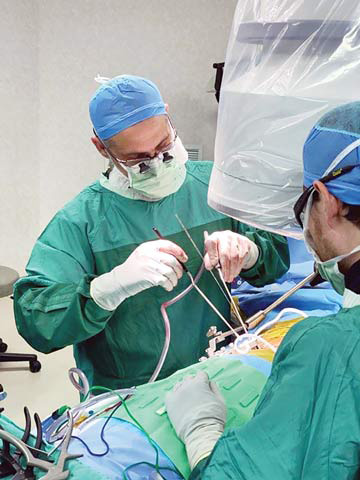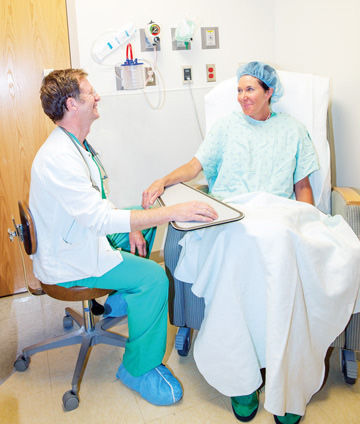The menu of procedures that can be safely performed in outpatient facilities continues to grow.
 CREDIT: Joseph Blythe
CREDIT: Joseph BlytheREDUCING TRAUMA Oblique lumbar interbody fusion (OLIF), which requires a smaller incision and less dissection than the anterior approach, is becoming popular in outpatient settings.
As exciting developments continue to make complex spine surgeries simpler to perform, more of these procedures are moving from inpatient hospitals to outpatient operating rooms and even doctors’ offices. As a result, same-day spine has become one of surgery’s hottest specialties. Here is a look at some of the top spine procedures moving to outpatient facilities:
Balloon kyphoplasty and vertebroplasty. These are the two most common treatments of vertebral compression fractures. Vertebroplasty involves injecting cement to stabilize vertebrae fractures. The treatment works in a high percentage of patients with non-displaced, compressive eggshell-like fractures, according to Robert E. Jacobson, MD, a neurosurgeon and spine specialist with OMNI Spine Center in Miami.
Balloon kyphoplasty can help to restore vertebrae height in addition to repairing the fracture. A balloon is slid into the fractured vertebrae and expanded to correct the deformity before the cement is injected into the space. To help prevent subsequent fractures of adjacent vertebrae, some surgeons use a titanium implant that resembles a car jack inside the fractured vertebra before cement or acrylic is injected, says Dr. Jacobson. Once the implant is deployed and locked in place, the surgeon injects cement into the vertebrae body.
Lumbar fusions. With anterior lumbar interbody fusion (ALIF) and oblique lumbar interbody fusion (OLIF), spine surgeons make incisions through the back, front or the side. While ALIF can require a large incision, particularly in heavier patients, the OLIF incision is smaller at about two or three inches, which allows for minimal dissection of muscle and tissue and limited disruption to underlying retroperitoneal organs, says Joseph Blythe, MD, a fellowship-trained spine surgeon in Nashville, Tenn.
Artificial disc technology. New discs increase cervical spine mobility and put less stress on adjacent discs, which leads to quick recoveries for patients. First-generation discs resembled a marble, but subsequent versions have progressed to a sliding ball bearing. Recent artificial discs designed from nanofibers woven in a ring around a soft-cushion center better mimic a native disc’s structure and can produce superior outcomes in the cervical and lumbar spine as a result. "It’s difficult to find reasons not to do it," says Dr. Blythe. "Patients present with herniated discs or stenosis at one or two levels, and two weeks later they’re back at work with no pain or symptoms."
Options for future growth. Evidence is growing that one- and two-level anterior cervical discectomy and fusion (ACDF), anterior cervical discectomy and fusion can be performed effectively and safely in same-day surgical settings. Minimally invasive transforaminal lumbar interbody fusion (TLIF) is beginning to emerge as an outpatient option as well.
The continuing developments that continue to improve balloon kyphoplasty, as well as other procedures, make the future of cost-effective outpatient spine very bright.
.svg?sfvrsn=be606e78_3)



.svg?sfvrsn=56b2f850_5)